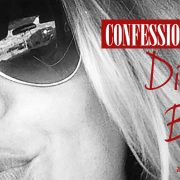Real editing isn’t automatic (Track Changes is evil)
As a reporter, I had the privilege of working with some of the finest editors in the country. I also worked with some real assholes. But I knew who was working on which night and planned my schedule accordingly. Some editors want to help polish stuff and some want to cut up your work to leave their own mark.

My other gun is a red pen.
You figure out fast who you can trust with your words and who has an agenda of his own – especially with deadline work. Stress brings out a person’s true nature. (There’s a reason that’s a cliché.)
The point? I knew what kind of editor I wanted, trusted and enjoyed working with. This made it très easy to establish what kind of editor I wanted to be.
The amazing people who had my back were easy to approach and talk to about problems with a story. They weren’t rushed or hurrying me, even though they had hours upon hours of editing to do that night for the next day’s paper. They always caught my gaffes, saving me from embarrassing myself in front of tens of thousands of people. They knew what made a good story, how hard it was to get it, how best to go after it, and had ideas about different ways to approach it. Because they were once reporters too.
They had “yes you can” attitudes and believed in me, even when I didn’t. They didn’t coddle and definitely didn’t put up with whining. They ALWAYS gave it to me straight. So whether they shredded my words or praised me, I knew I could trust them. They always told me the truth.
They saved my ass. Fixed my mistakes. Had my best interests in mind. And cared about my words. They were personally invested in a professional job.
I strive to be like those people. Those of you who have worked with me are likely nodding your heads right now. And if not, you better kick my ass.
A good editor wants to help you. Because your success is her success. Every time you get a 5-star review, she does too. Every time someone bitches about the misuse of to, too and two in your manuscript, a little part of her dies.
Sooooo, dragging you down and shaming you are not productive. Waggling a finger or thumbing my nose because you made a mistake is stupid. It’s the editor’s job to fix the fucking thing, not judge.
The best editors lift you up and make your shit shine, furthering your positive self-image. Because that’s what fuels more fine-as-fuck words.
“But Becky, why don’t you use Track Changes when you edit? I mean, it’s, like, the industry standard.”
Not acquainted? Below is an image edited with Microsoft Word’s Track Changes function.
I despise it.

Why do I have an unfettered dislike for what appears to be a benign computer function? I’ll tell you.
Because it makes me feel like a teacher, and you a student. And we’re not. We’re two professionals coming together to make one awesome book. And studies show the whole red pen routine sucks the life out of writers.
Because it’s far too easy to click “Accept” or “Reject” using said computer function. You don’t have to think about why I made a particular suggestion. And I don’t have to think about why you’re opposed. In a nanosecond, we can click and make hours of painstaking professional conversation disappear.
Because writing is a thinking man’s work. If you can’t slow down long enough to give YOUR manuscript 100 percent of your attention – if you don’t want to get elbow-deep in the muck and mire of writing the best book you can – then I don’t want to work with you.
So how do I edit?
With highlighting, bold and strike-through. For a few reasons.
The first and most notable is I was trained using something similar. Those awesome editors I spoke of earlier? THIS.
Whatever it’s called, when we hit a particular Ctrl function, it automatically inserted a light blue font in brackets. If, for some reason, we left blue notes in the document and it went to print, the blue never printed. It was invisible. Nifty, eh?
But more importantly, when I opened a story with those blue marks side-by-side with my own words, I felt as though my editors were talking TO me. They were in the trenches beside me, making me slow down and take a long, hard look at what they did and why.
And the why matters most when editing. (Click to tweet.)
Writers need to know what you’re doing to make them better. They want to learn. They want to trust you. Give them reasons.
Anyway, since that software exists in the newspaper world and not on any home computer, I’ve adapted my style. The pages I edit end up looking something like this.
Is it perfect? No.
Is it bold? Yes. (So am I.)
Am I jotting notes in red pen in the margin like some third-grade teacher? Leaving tiny comments in boxes off to the side? No. And fuck no.
It is, however, the closest approximation to the kind of editing experience I was lucky enough to have early in my career. It also takes more time to edit than with Track Changes.
The sacrifices we make for our art. (Or in this case, YOUR art.)
Every day, I sit at my computer poring over hundreds of thousands of other people’s words. I tell myself the same thing repeatedly: You know what kind of editor you want to be.
So here’s my question for you: What kind of editor do you want?
*
RebeccaTDickson.com celebrates one year in biz on December 2nd. We’re partying Becky-style that day (and night). I’ve got a special something-something for folks on Twitter and Facebook, and something FUCK-YEAH exclusive for my subscribers. Get on the list, dahhhhlings. Subscribe and get awesome using the box on the upper right.






That’s why I love ya. And your potty mouth.
I FUCKING LOVE YOUR EDITS. I can see what you changed and I must make the corrections. Engaging, instructive AND it gives me license to bombastically announce to people who enter my home, “This is a house of a learned writer.”
http://youtu.be/hh1oaumUoyc
I like tracked changes, but maybe that’s my legal training. I’m trained NEVER to accept a change without thoroughly thinking about it first – because you never know what nasty surprise the other side’s lawyer might have slipped in there. I guess I am accustomed to receiving tracked changes from someone I don’t trust, and so even with my editor I apply a critical mind to the suggestions.
Your method, to me, doesn’t look any different – it just avoids the ‘auto-accept’ issue. I don’t think it’s any less school-teacherish, although if you dislike comment boxes, you can use tracked changes in the same way you are making comments – by typing comments directly into the body of the text. Interestingly enough, that would force writers to think, too, because they can’t auto-accept, as they would be accepting your comments into their story – oops! You can also change the colour of tracked changes if you dislike red.
I think the problem here is lack of discipline on the part of the writer, not the tool being used, because you can use the same tool in a different way to force the writer’s behaviour to change.
Is it an editor’s job to make a writer more disciplined? I’m not sure I have an answer in current times, although I think certainly in days gone by an editor would expect a writer to already be disciplined by the time they started working with the editor.